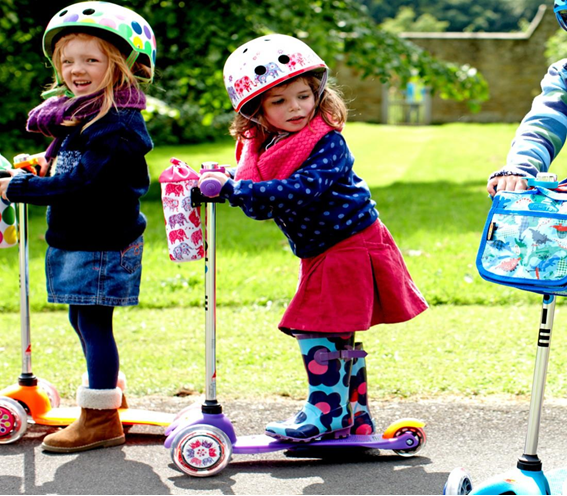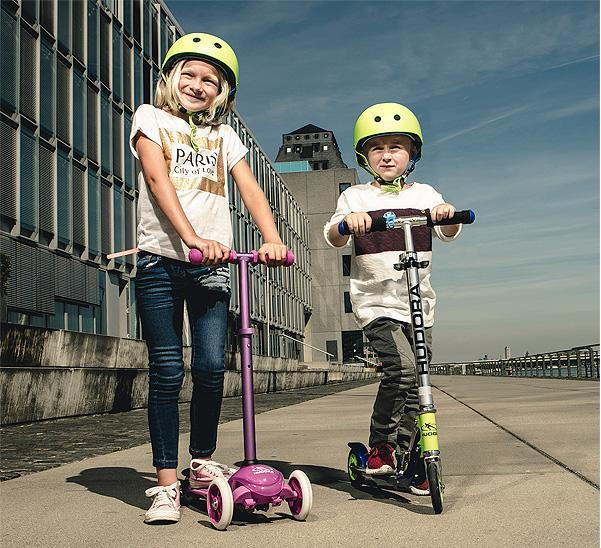What is the age limit for riding a scooter?
Published :
08/17/2020 09:01:41
Categories :
Video tips from pediatricians
It seems to you that only yesterday your little treasure made his first steps on his own, and today he is asking you to buy him a scooter. You know that once he has expressed a desire to learn to ride a children's scooter, he will not give up so easily, so you have no choice but to do some research before buying a scooter.
We believe experience matters in aspect such as as this, hence, the reason we are in a better position to give you some answers to the questions that concern you. That's why we have compiled a short guide to buying a children's scooter, which we hope will be useful to you.
At what age are children ready to get on a children's scooter?
According to experts, riding skills do not depend so much on the age of children as on their physical development. If the little ones are able to walk steadily, are active and constantly jump and run, this is an indication that they can also cope with riding a children's scooter.
Again, according to experts, this stage of physical development of young ones takes about two years of age.
In other words, if your child is 2+ years old and physically well developed, there is no reason not to buy his first scooter.
How to choose the right scooter for the child's age?
Although, as we have just mentioned, it is not so much about age as with physical development, this is what is important in mastering driving techniques, these vehicles are still divided into several main groups according to the age of the children:
- 2 - 3 years
Usually children in this age group have the necessary riding skills, but they need some time to learn to balance. That is why self-balancing scooters with three wheels are suitable for them. This type of vehicle has the following distinctive features:
- Smaller wheels (so that the little ones can't go at high speeds)
- A broader basis (which allows them to learn balance)
- Convenient steering wheel
Depending on the model, this type of scooter can be either with one wheel at the front and two at the rear or vice versa (with two at the front and one at the rear). There are also models that are equipped with a seat, basket and other extras.
If you are looking for our opinion on choosing a first scooter, then we suggest that you go for the children's scooter with two wheels at the front and one at the back.
3 - 5 years
At this age, children can now balance and manage without a problem. If your little one falls into this age group, but this will be his first scooter, then the best choice for him are the models of children's scooters with three wheels.
If he already know how to drive this vehicle, you can consider buying a scooter with two wheels. Keep in mind, however, that two-wheeled children's vehicles develop higher speeds because they have higher and narrower tires and a shorter base (platform).
5 - 7 years
Children of this age have excellent coordination and can ride the scooter without any problems. If this is the age group that your child belongs to, you can easily buy him a scooter on two wheels. Children at this age like to develop higher speeds, do their first tricks and will hardly need your help to learn to drive like professionals.
Other features that influence the choice of scooters
Tire width and size
The width and size of the tires affect the stability and speed that the scooter can develop (the wider the wheels, the more stable and slower the children's vehicles becomes). Therefore, if you are looking for a scooter for a small child (2 - 5 years), an excellent choice would be scooters with wide tires. And if you choose a means of transportation for an older child, the better option would be narrower and taller tires.
Platform (base)
The rule here is this: The wider and shorter platform is suitable for younger children, as it provides better stability, while the narrower and longer base is suitable for older children.
Material
The materials from which scooters are made are several: plastic, steel and aluminum. (There are also wooden scooters, but they are rare because they are not durable at all).
Scooters made entirely of plastic are lightweight, affordable and easy to drive. Their only drawback is that they are not very durable. They are suitable for the first scooter for the little ones, but be prepared to buy a new one in a few months.
Steel scooters are just the opposite. They are extremely durable, but difficult to manage because they are quite heavy. They are a good choice for older children, as they increase their concentration.
Children's aluminium vehicles seem to take the best of both plastic and steel. They are lightweight, but at the same time quite durable. Aluminum scooters are a suitable choice for all ages.
Handlebar and handles
There are models of scooters that have a fixed height of the handlebars. However, this option is not very suitable, especially considering that children grow quickly and only after a few months the height of the handlebars may not be comfortable. Therefore, our advice is, to choose a scooter with an adjustable handlebar according to the child's height.
The handles are important for a stable grip, so it is good to pay special attention to them. Handles are made of polyurethane are a good choice, as they are both ergonomic and rough enough that the child cannot lose control of the scooter if his hands are too sweaty.
Brakes
All types and models of scooters are equipped with brakes. Some models have rear brakes and others front (like a bicycle). If the child is small, the better choice is to opt for a model with rear brakes. Not that the front ones are bad, it's just that the little ones still don't have a good instinct and quite often apply the front brake for no reason or too sharply, and this can cause the child to fall.
Should you teach your child to ride a scooter?
No matter how confident a child is, it is still a vehicle and in order to learn to drive it without a problem, you have to help him. Experts advise at the beginning to just explain to the little one how to ride and only then start the lessons.
For the first few days, it is advisable to train the child indoors, and only after he learns to ride confidently in a straight line, can he go outside and show him how to turn, apply the brakes and more. Once you have made sure that he has mastered the basic rules of riding, you can let him ride on his own. But even then, you must always be close-by and ready to come to his aid.
What safety measures should you take?
- To ensure the safety of the little one, it is necessary to equip him with a helmet, knees and elbows pads. In addition to this equipment, it is good to buy and put reflective stickers on the scooter.
- Do not allow the child to ride the scooter without parental supervision. Whenever the little one goes outside to ride, endeavour to go out with him and stay nearby. Follow his every move, be alert and ready to help. Do not allow him to drive in places or on streets where there is heavy.
What to do in case of an accident?
Children often fall and injure themselves. Thank God, their injuries are usually not serious and the little ones are ready to get on the scooter again in just a short time.
Therefore, if the child accidentally falls off the scooter, do not rush to panic, but approach slowly and calmly to check his injuries. If it's just bruised or has scratched his legs and arms, he should be advised to go home and get the area treated and cleaned up as carefully as possible.
However, if the injury appears to be serious, call your GP or 112 immediately.





 Back
Back